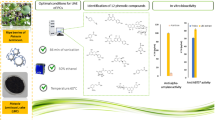Abstract
Eucomis (Family Hyacinthaceae) bulbs are greatly valued in traditionalmedicine for the treatment of a variety of ailments, predominantly thoseinvolving pain, fever and inflammation. The COX-1 assay was used to screenethanolic extracts prepared from the dried leaves, bulbs and roots of E. autumnalis (subspecies autumnalis) to determine the variation ofanti-inflammatory activity with age and season of harvest. Young plantswere found to have large amounts of COX-1 inhibitory activity, particularlyin the leaves. As the plant matured, greater activity was associated with thebulb and root extracts. The anti-inflammatory activity of the leaf, bulb androot extracts varied slightly throughout the year, with the greatest levelsdetected towards the end of the growing season, shortly before the onsetof dormancy. A seaweed application (Kelpak) decreased the anti-inflammatory activity of the leaf, bulb and root extracts, while increasedtemperature/increased light intensity had no significant effect on theCOX-1 inhibitory activity of the leaf extracts. The bulb extracts fromtreated plants harvested towards the end of the growing season showed asignificant decrease in anti-inflammatory activity, while the anti-inflammatory activity of the corresponding not root extracts increased.
Similar content being viewed by others
References
Anton R, Haag M and Kuballa B (1986) Biological and therapeutic activity. The evaluation of substances derived from natural sources. In: Barton D and Ollis WD (eds) Advances in Medical Phytochemistry. Proceedings of the International Sympoisum on Medicinal Phytochemistry. London: John Libbey & Co., pp 13–24. ISBN 0-86196-092-0
Campbell WB (1990) Lipid-derived autocoids: Eicosanoids and platelet activating factor. In: Gilman AG, Rall TW, Nies AS and Taylor P (eds) The Pharmacological Basis of Therapeutics, 8th edn. New York: Pergamon Press, pp 600–617
Compton J (1990) Eucomis L'Heritier. Plantsman 12: 129–139
Crouch IJ and van Staden J (1992) Effect of seaweed concentrate and applied hormaones on the establishment and yield of greenhouse tomato plants. J Appl Phycol 4: 291–296
Cunningham AB (1988) An Investigation of the Herbal Medicine Trade in Natal/KwaZulu. Investigational Report No 29. Institute of Natural Resources, South Africa
De Hertogh AA and Le Nard M (1993) The Physiology of Flower Bulbs. The Netherlands: Elseiver Science Publ, pp 752–753. ISBN 0-444-87498-44
Featonby-Smith BC and van Staden J (1984) The effect of seaweed concentrate and fertilizer on growth and the endogenous cyctkinin content of Phaseolus vulgaris. S A J Bot 3: 375–379
Goetzel EJ, An S and Smith WL (1995) Specificity of expression and effects of eicosanoid mediators in normal physiology and human diseases. FASEB 9: 1051–1058
Hinman JW (1973) Round table discussion on inflammation. In: Kahn RH and Lands WEM (eds) Prostaglandins and Cyclic AMP. Biological Actions and Clinical Applications. New York: Academic Press, pp 207–210. ISBN 0-12-3944503
Hutchings A, Scott AH, Lewis G and Cunningham AB (1996) Zulu Medicinal Plants. An Inventory. South Africa: University of Natal Press, pp 42–43. ISBN 0-86980-923-7
Iwu MM (1993) Handbook of African Medicinal Plants. Florida: CRC Press, pp 1–7, 42. ISBN 0-849-34266-X
Jäger AK, Hutchings A and van Staden J (1996) Screening of Zulu medicinal plants for prostaglandin-synthesis inhibitors. J Ethnopharm 52: 95–100
Lindsey KL, Jäger AK and van Staden J (1998) Effect of a seaweed concentrate on acclimatization of in vitro plantlets of Kniphofia pauciflora and Scilla krausii. S A J Bot 262–264
Màthá Á (1988) An ecological approach to medicinal plant introduction. In: Craker LE and Simon JE (eds) Herbs, Spices 47 and Medicinal Plants: Recent Advances in Botany, Horticulture and Pharmacology, Vol 3. USA: Oryx Press, pp 175–205. ISBN 0-89774-360-1
O'Neil MJ and Lewis JA (1993) The renaissance of plant research in the pharmaceutical industry. In: Kinghorn AD and Balandrin MF (eds) Human Medicinal Agents from Plants. ACS Symposium Series 534. Washington: American Chemical Society, pp 48–55. ISBN 0-8412-2705-5
Pienaar K (1984) The South African What Flower is That? Cape Town: Struik Publishers. ISBN 0-86977-201-5
Prance GT (1994) Introduction. In: Ethnobotany and the Search for New Drugs. Ciba Foundation Symposium 185. Chichester: John Wiley & Sons, pp 1–3. ISBN 0-471-95024-6
Roberts M (1990) Indigenous Healing Plants. Cape Town: Creda Press, p 251. ISBN 1-86812-317-0
Smith JB (1990) Prostaglandins and related eicosanoids. In: DiPalma JR and DiGregorio GJ (eds) Basic Pharmacology in Medicine, 3rd edn. New York: McGraw-Hill Publ, pp 181–192. ISBN 0-07-017013-4
Taylor JLS, Rabe T, McGaw LJ, Jäger AK and van Staden J (2001) Towards the scientific validation of traditional medicinal plants. Pl Gr Reg 34: 23–37 (this issue)
Taylor JLS and van Staden J (2001) Anti-inflammatory activity in Eucomis L'Herit. species. J Ethnopharmacol (in press)
Tunón H, Olavsdotter C and Bohlin L (1995) Evaluation of anti-inflammatory activity of some Swedish medicinal plants. Inhibition of prostaglandin biosynthesis and PAF-induced exocytosis. J Ethnopharmacol 48: 61–67
Van Staden (1999) Medicinal plants in southern Africa: Utilization, sustainability, conservation - can we change the mindsets? Outlook Agric 28: 75–76
Van Wyk B-E, van Oudtshoorn B and Gericke N (1997) Medicinal Plants of South Africa. Pretoria: Briza Publications, pp 8–22, 130. ISBN 1-875-93-09-5
Vane JR and Botting RM (1995) New insights into the mode of action of anti-inflammatory drugs. Inflamm Res 44: 1–10
Watt JM and Breyer-Brandwijk M (1962) The Medicinal and Poisonous Plants of Southern and Eastern Africa. London:Livingstone
White HL and Glassman AT (1974) A simple radiochemical assay for prostaglandin synthetase. Prost 7: 123–129
Zschocke S, Rabe T, Taylor JLS, Jäger AK and van Staden J (2000) Substitution of plant parts - an alternative for sustainable use? J Ethnopharmacol (in press)
Author information
Authors and Affiliations
Rights and permissions
About this article
Cite this article
Taylor, J., van Staden, J. The effect of age, season and growth conditions on anti-inflammatory activity in Eucomis autumnalis (Mill.) Chitt. Plant extracts. Plant Growth Regulation 34, 39–47 (2001). https://doi.org/10.1023/A:1013366926113
Issue Date:
DOI: https://doi.org/10.1023/A:1013366926113



